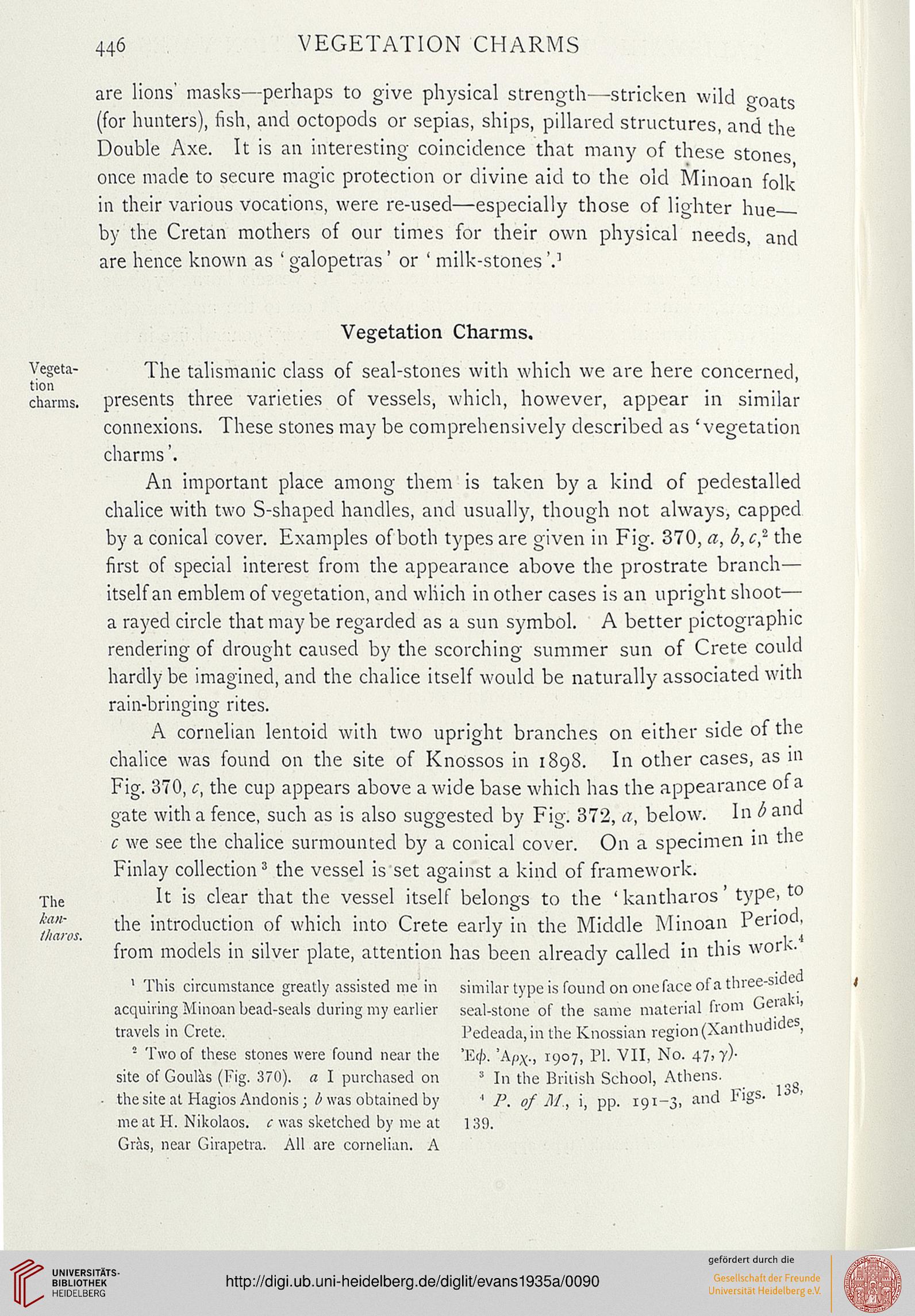446 VEGETATION CHARMS
are lions' masks—perhaps to give physical strength—stricken wild goats
(for hunters), fish, and octopods or sepias, ships, pillared structures, and the
Double Axe. It is an interesting coincidence that many of these stones
once made to secure magic protection or divine aid to the old Minoan folk
in their various vocations, were re-used—especially those of lighter hue__
by the Cretan mothers of our times for their own physical needs, and
are hence known as ' galopetras' or ' milk-stones'.'
Vegetation Charms.
Vegeta- The talismanic class of seal-stones with which we are here concerned,
charms, presents three varieties of vessels, which, however, appear in similar
connexions. These stones may be comprehensively described as 'vegetation
charms'.
An important place among them is taken by a kind of pedestalled
chalice with two S-shaped handles, and usually, though not always, capped
by a conical cover. Examples of both types are given in Fig. 370, a, b, c*- the
first of special interest from the appearance above the prostrate branch—
itself an emblem of vegetation, and which in other cases is an upright shoot—
a rayed circle that maybe regarded as a sun symbol. A better pictographic
rendering of drought caused by the scorching summer sun of Crete could
hardly be imagined, and the chalice itself would be naturally associated with
rain-bringing rites.
A cornelian lentoid with two upright branches on either side of the
chalice was found on the site of Knossos in 1898. In other cases, as in
Fig. 370, c, the cup appears above a wide base which has the appearance of a
gate with a fence, such as is also suggested by Fig. 372, a, below. In 0 and
c we see the chalice surmounted by a conical cover. On a specimen in the
Finlay collection3 the vessel is set against a kind of framework.
The It is clear that the vessel itself belongs to the ' kantharos' type, to
i'f"' the introduction of which into Crete early in the Middle Minoan Period.
tlmros. _ _ J 1. .1
from models in silver plate, attention has been already called in this work.
1 This circumstance greatly assisted me in similar type is found on one face of a three-si
acquiring Minoan bead-seals during my earlier seal-stone of the same material from uer j
travels in Crete. Pedeada,in the Knossian region(Xanthudi e ,
2 Two of these stones were found near the 'E</>. 'Apx., rq/07, PI. VII, No. 47, y)-
site of Goulis (Fig. 370). a I purchased on s In the British School, Athens.
■ the site at Hagios Andonis; b was obtained by ■' P. of M., i, pp. rQi-3, and Figs,
meat H. Nikolaos. c was sketched by me at 139.
Giis, near Gkapetra. All are cornelian. A
are lions' masks—perhaps to give physical strength—stricken wild goats
(for hunters), fish, and octopods or sepias, ships, pillared structures, and the
Double Axe. It is an interesting coincidence that many of these stones
once made to secure magic protection or divine aid to the old Minoan folk
in their various vocations, were re-used—especially those of lighter hue__
by the Cretan mothers of our times for their own physical needs, and
are hence known as ' galopetras' or ' milk-stones'.'
Vegetation Charms.
Vegeta- The talismanic class of seal-stones with which we are here concerned,
charms, presents three varieties of vessels, which, however, appear in similar
connexions. These stones may be comprehensively described as 'vegetation
charms'.
An important place among them is taken by a kind of pedestalled
chalice with two S-shaped handles, and usually, though not always, capped
by a conical cover. Examples of both types are given in Fig. 370, a, b, c*- the
first of special interest from the appearance above the prostrate branch—
itself an emblem of vegetation, and which in other cases is an upright shoot—
a rayed circle that maybe regarded as a sun symbol. A better pictographic
rendering of drought caused by the scorching summer sun of Crete could
hardly be imagined, and the chalice itself would be naturally associated with
rain-bringing rites.
A cornelian lentoid with two upright branches on either side of the
chalice was found on the site of Knossos in 1898. In other cases, as in
Fig. 370, c, the cup appears above a wide base which has the appearance of a
gate with a fence, such as is also suggested by Fig. 372, a, below. In 0 and
c we see the chalice surmounted by a conical cover. On a specimen in the
Finlay collection3 the vessel is set against a kind of framework.
The It is clear that the vessel itself belongs to the ' kantharos' type, to
i'f"' the introduction of which into Crete early in the Middle Minoan Period.
tlmros. _ _ J 1. .1
from models in silver plate, attention has been already called in this work.
1 This circumstance greatly assisted me in similar type is found on one face of a three-si
acquiring Minoan bead-seals during my earlier seal-stone of the same material from uer j
travels in Crete. Pedeada,in the Knossian region(Xanthudi e ,
2 Two of these stones were found near the 'E</>. 'Apx., rq/07, PI. VII, No. 47, y)-
site of Goulis (Fig. 370). a I purchased on s In the British School, Athens.
■ the site at Hagios Andonis; b was obtained by ■' P. of M., i, pp. rQi-3, and Figs,
meat H. Nikolaos. c was sketched by me at 139.
Giis, near Gkapetra. All are cornelian. A




